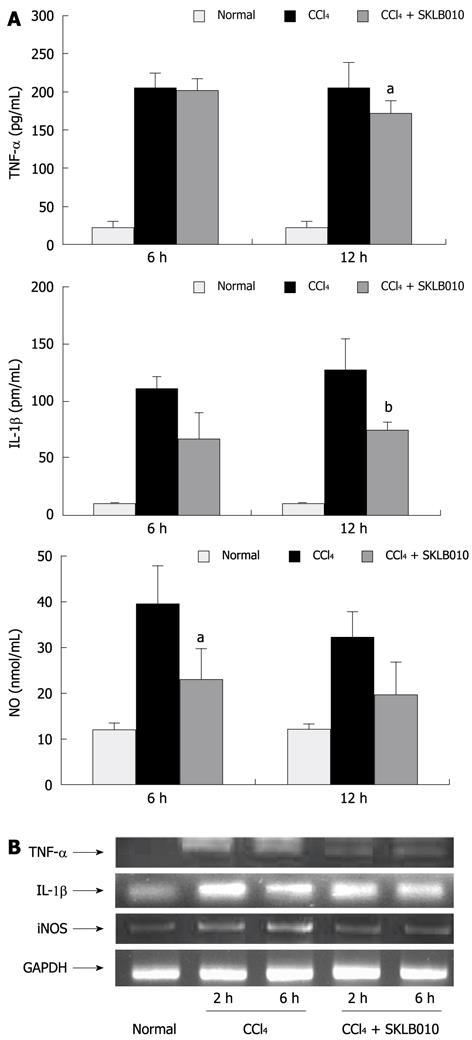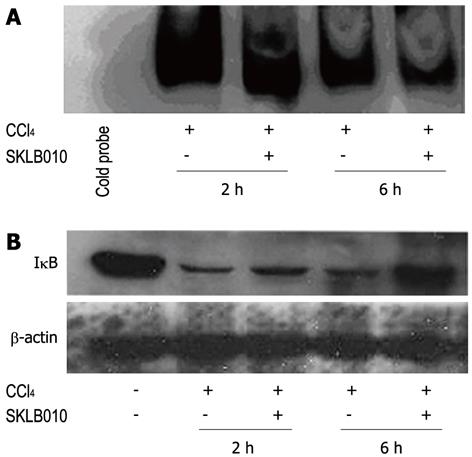Copyright
©2012 Baishideng Publishing Group Co.
World J Gastroenterol. Feb 21, 2012; 18(7): 654-661
Published online Feb 21, 2012. doi: 10.3748/wjg.v18.i7.654
Published online Feb 21, 2012. doi: 10.3748/wjg.v18.i7.654
Figure 1 Effect of (Z)-5-(4-methoxybenzylidene)thiazolidine-2,4-dione on carbon tetrachloride-induced hepatitis.
A: The structure of (Z)-5-(4-methoxybenzylidene)thiazolidine-2,4-dione (SKLB010); B: Representative liver histology of the rats in each group at 24 h after carbon tetrachloride (CCl4) injection, liver sections were stained with hematoxylin-eosin (original magnification 200 ×); C: Time course of hepatocyte necrosis after CCl4 challenge, alanine aminotransferase (ALT) was measured in serum collected at time points as indicated. Values are presented as mean ± SD of the mean. (n = 5, aP < 0.05 vs the level in the model group).
Figure 2 SKLB010 reduces the production of inflammatory mediators in vivo.
A: Blood was collected at different time points (5 rats per time point). Tumor necrosis factor-α (TNF-α), and interleukin-1β (IL-1β) were assayed in serum using an enzyme linked immunosorbent assay (mean ± SD). Nitric oxide (NO) was assayed in serum using a NO assay kit aP < 0.05, bP < 0.01 vs the level of carbon tetrachloride (CCl4) administration at each time point; B: Total RNA was prepared at different time points for the reverse transcription-polymerase chain reaction (RT-PCR) analysis of TNF-α, IL-1β and iNOS gene expression. IL-1β-specific sequences (387 bp), TNF-α-specific sequences (351 bp) and inducible nitric oxide synthase (iNOS)-specific sequences (474 bp) were detected by agarose gel electrophoresis, as described in Methods. PCR of glyceraldehyde-3-phosphate dehydrogenase (GAPDH) was performed to verify that the contents of the samples were similar.
Figure 3 SKLB010 prevented the nuclear translocation of nuclear factor-κB by inhibiting degradation of IκB.
A: The inhibition of nuclear factor-κB (NF-κB)-DNA binding. Carbon tetrachloride (CCl4)-mediated activation of NF-κB resulted in an increase in DNA-binding activity of NF-κB within 2 h, followed by inactivation of NF-κB at 6 h after stimulation which was demonstrated by a lower DNA-binding activity; B: SKLB010 inhibited the CCl4-induced degradation of IκB. Total tissue proteins were analyzed by Western blotting at different time points for IκB-α using specific IκB antibodies. β-actin was used as an internal control.
Figure 4 SKLB010 improves liver function and causes a marked reduction in liver fibrosis.
Arrows points to positive direction. aP < 0.05, bP < 0.01. A: Hematoxylin-eosin (original magnification 200 ×); B: Masson (original magnification 100 ×) and digital image analysis quantification of collagen; C: α-smooth-muscle actin (SMA) original magnification 400 ×) and digital image analysis quantification of α-SMA; D: CD-11b (original magnification 400 ×) and digital image analysis quantification of macrophages. CCl4: Carbon tetrachloride.
- Citation: Chen ZZ, Wang ZL, Deng CY, Zheng H, Wang XH, Ma L, Ye X, Ma YH, Xie CF, Chen LJ, Wei YQ. (Z)-5-(4-methoxybenzylidene)thiazolidine-2,4-dione protects rats from carbon tetrachloride-induced liver injury and fibrogenesis. World J Gastroenterol 2012; 18(7): 654-661
- URL: https://www.wjgnet.com/1007-9327/full/v18/i7/654.htm
- DOI: https://dx.doi.org/10.3748/wjg.v18.i7.654












